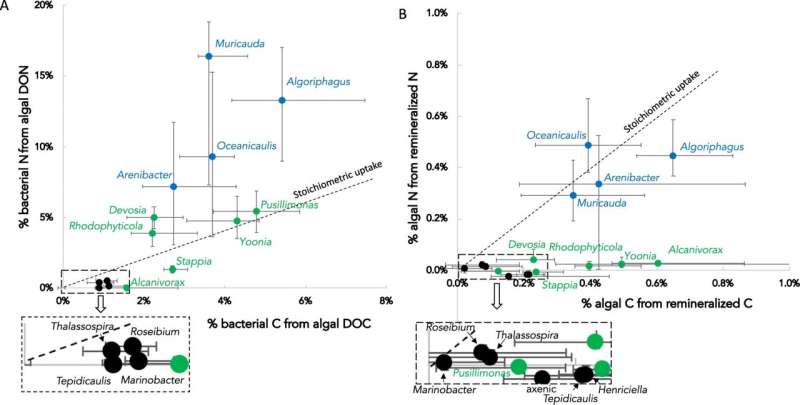This article has been reviewed according to Science X's editorial process and policies. Editors have highlighted the following attributes while ensuring the content's credibility:
fact-checked
peer-reviewed publication
trusted source
proofread
Understanding nutrient cycling between algae and bacteria could lead to increased biofuel production

The interactions between algae and bacteria are essential to the primary productivity of Earth's oceans and surface waters. Bacteria can increase the productivity of algae by producing key factors, such as vitamins, iron-chelating molecules, and growth hormones. In addition, bacteria remineralize organic matter—a process that provides a steady supply of nutrients to algae. However, not much is known about this process.
Now a study details uptake of organic matter from algae and remineralization by 15 bacterial co-cultures and subsequent incorporation of the resulting nutrients by the algae Phaeodactylum tricornutum, a diatom. The work is published in the journal Nature Communications.
Although algae are an essential part of primary productivity in places like the ocean, details about their relationships with bacteria are lacking. This study quantifies bacterial uptake of algae-derived nutrients and subsequent incorporation of remineralized carbon and nitrogen by the algae. The researchers also identified three separate categories of metabolic interactions that open the doors for future research into this field, including ecological studies, helping close the gap between what is and isn't known about interactions between bacteria and algae.
These research findings lend important details for potentially enhancing algal biomass for biofuel production, and generally for understanding large-scale elemental cycling.
Remineralization of organic matter by bacteria is vital for growth of algae, but not much is known about the process. Thus, identifying the bacteria that can provide more remineralized nutrients to algae is currently not possible. This study, for the first time, quantifies both the incorporation by bacteria of dissolved organic carbon and nitrogen from algae and the reverse process, where remineralized nutrients are subsequently incorporated by algae.
Fifteen bacterial co-cultures were grown alongside the diatom Phaeodactylum tricornutum, and carbon and nitrogen movement between the cells was tracked and analyzed using single-cell-level isotope tracing and nanoscale secondary ion mass spectrometry. Additional metabolomics and proteomics data were acquired at the Environmental Molecular Sciences Laboratory (EMSL), a Department of Energy (DOE) Office of Science user facility at Pacific Northwest National Laboratory.
Unexpectedly, the multi-institutional team identified variability between strains and even between cells in net carbon and nitrogen incorporation, use, and remineralization. Using the resulting data, the team identified three categories, or guilds, of metabolic interactions: macromolecule remineralizers, macromolecule users, and small-molecule users. These guilds were not connected to phylogeny, nor could they be elucidated exclusively from predicted metabolic capacity.
This work provides a key stepping stone in understanding bacterial-algal relationships and emphasizes the need for additional research, including ecological studies of microbial metabolic interactions.
More information: Xavier Mayali et al, Single-cell isotope tracing reveals functional guilds of bacteria associated with the diatom Phaeodactylum tricornutum, Nature Communications (2023). DOI: 10.1038/s41467-023-41179-9
Journal information: Nature Communications
Provided by Environmental Molecular Sciences Laboratory


















